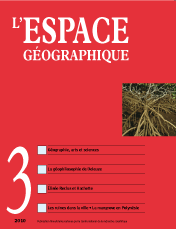

The poetics and rhetoric of maps in contemporary art (7 fig., 2 photos)
Artists who work with maps investigate how they are made and how we read them. Intended to be consulted, atlases are also designed to be looked at and read. For users, map-lovers and geographers, the legends and place names are a source of information but also of pleasure, which reveals the role of imagination in any cartographic activity.
keyword: ATLAS, CONTEMPORARY ART, IMAGINATION, MAPPING, POETRY
Spatial approaches in the history of science and art
References to geography in cultural studies have become increasingly common over the past 20 odd years. This paper first proposes a brief overview of the literature and the concepts that have developed in the history of art and science. It then analyses some of the epistemological and historiographical consequences of that research, particularly for geography.
keyword: GEOGRAPHY OF ART, HISTORY OF SCIENCE, KNOWLEDGE
Cartography and territories: geographical space as an analyser of the forms of subjectivity, according to Gilles Deleuze
This article deals with the question of space in Deleuze's work. It examines his original concept of cartography, his theory of affective geographies, and his analysis of the vectors of “territorialisation” and “deterritorialisation”, which determine collective identities and their transformations. This paper thus emphasises the fact that Deleuze’s concept of space was the cornerstone of a wholly new definition of the critical task of philosophy. To think “in space” is a way of posing problems and creating concepts, and thus represents a “geophilosophy” rather than a philosophy of geography.
keyword: CARTOGRAPHY, ETHOLOGY, GEOPHILOSOPHY, PSYCHOANALYSIS, TERRITORY
The Reclus and Hachette publishers: the first agency of French geography?
In an 1872 article, ÉliséeReclus described ÉdouardCharton, the editor of Tour du Monde, as “the educator of the nation”, because of the important geographical information that his journal was alone in disseminating at the time. Practically every major French geographer in the second half of the 19th century published with Hachette. Could the publishing house be considered the main agency for the production of geographic knowledge in France before the discipline was institutionalised at French universities? What was the role of geographers like Reclus, who were often considered to be outside the mainstream? This paper analyses Hachette’s archives and the publications from the second half of the 19th century.
keyword: HACHETTE, PUBLISHING, RECLUS, TOUR DU MONDE
The conservation of traumatic urban ruins as an ambiguous marker of urban history (1 fig., 3 photos)
Urban ruins are non-functional buildings and as such are unwelcome in most cities. Preserved ruins, however, convey a social and political message, sometimes with great impact. In particular, ruins due to disasters are sometimes preserved to generate risk awareness by preserving the spatial marks left by the disaster. However, the message of a ruin can be ambiguous and depends on specific urban planning choices. Many municipalities, in various contexts, have chosen to preserve traumatic ruins, thus modifying subsequent urban planning trends.
keyword: CONSERVATION, DISASTER, HAZARD, RISK MITIGATION, RUIN
Alien mangrove in remote archipelagos of Oceania, between assimilation and rejection (4 fig.)
Deliberately introduced for economic reasons to the remote Hawaiian and Society Archipelagos where it did not exist naturally, mangrove colonised large swathes of coastal areas within a few decades. This alien ecosystem is now part of the landscape but still a source of controversy because of its real or potential ecological impact. Rejected by Hawaiian society, amid Polynesian cultural revival and efforts to protect biodiversity, it is being assimilated in French Polynesia, where conflicts of interest have led to inaction and indifference. A negative opinion of the mangrove is common to both archipelagos and contradicts the usual image of this form of vegetation as a nutrient environment and a regulator of the natural balance in tropical coastal areas.
keyword: CONFLICT, CULTURE REVIVAL, MANGROVE, SPECIES
The United Nations General Assembly from 1985 until today (1 fig.)
The UN General Assembly is a rich field of observation for capturing the dynamics of the World-System, in terms of both the positions of the actors and the content of the resolutions adopted. This paper describes various methodological tools that can contribute to a geographical analysis of this institution.
keyword: POLITICAL GEOGRAPHY, REGIONALISATION, SPEECH ANALYSIS, UNITED NATIONS ORGANIZATION, WORLD SYSTEM
Book reviews
In this issue of l’Espace géographique, you will find critical reviews of the following books
ORAIN O. (2009). De plain-pied dans le monde. Paris: éditions de l’Harmattan, coll. «Histoire des sciences humaines», 432 p. (Bernard Debarbieux, université de Genève)
Baron-Yellès N. (2009). France. Aménager et développer les territoires en France. Paris: La Documentation française, coll. « Documentation photographique », dossier n° 8067, 64 p. (Giovanni Fusco, université de Nice-Sophia Antipolis)
Stopani A. (2008). La Production des frontières. état et communautés en Toscane (XVIe-XVIIIe siècles). Rome: école française de Rome, 450 p. (Claude Bataillon, CNRS Toulouse)
Deprest F. (2009). Géographes en Algérie (1880-1950), savoirs universitaires en situation coloniale. Paris: Belin, 348 p. (Claude Bataillon, CNRS Toulouse)
Verdès-Leroux J. (dir.)(2009). L’Algérie et la France. Paris: Robert Laffont, coll. «Bouquins», 900 p. (Claude Bataillon, CNRS Toulouse)
Simon C. (2009). Algérien, les années pieds-rouges, des rêves de l’indépendance au désenchantement (1962-1969). Paris: La Découverte, 286 p. (Claude Bataillon, CNRS Toulouse)
Frémont A. (2009). Normandie sensible. Paris: éditions Cercle d’Art, coll. «Diagonales», 258 p. (Claude Bataillon, CNRS Toulouse)
Ethnologie française (2009). «Météo, du climat et des hommes». Vol. XXXIX, n° 4, octobre-décembre, 764 p. (Pierre Usselmann, CNRS Montpellier)
L’espace géographique 2/10![]()
![]() L’espace géographique 4/10
L’espace géographique 4/10
For subscribe or buy this issue: BELIN
![]() L’Espace géographique: contents
L’Espace géographique: contents
Last modified: April 2, 2013